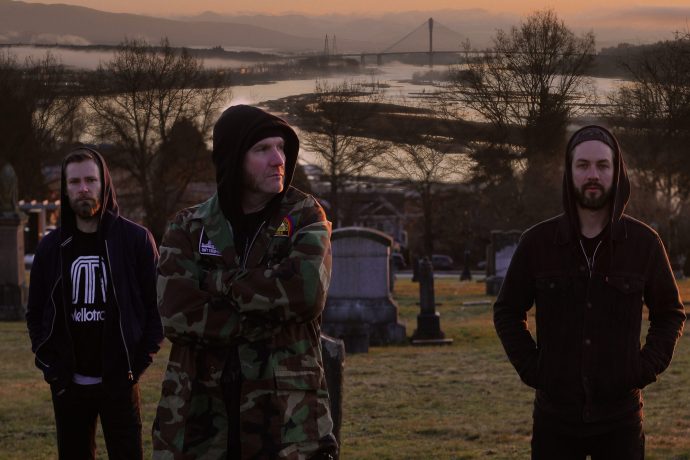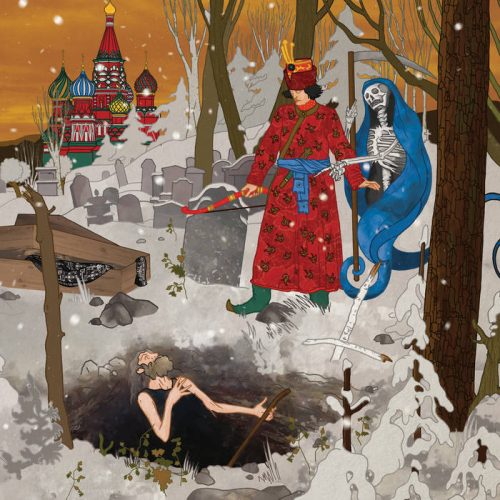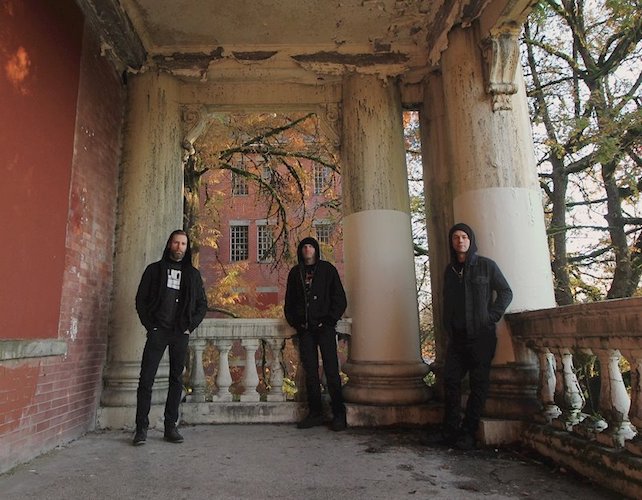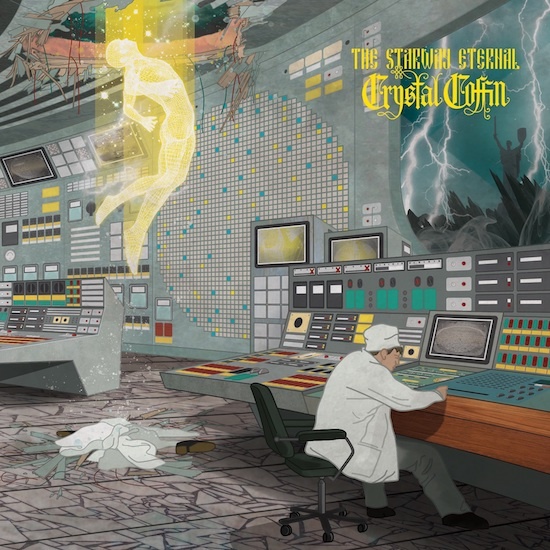
(The music, the artwork, and the lyrics of Vancouver-based Crystal Coffin are fascinating in and of themselves, but reveal themselves to be even more fascinating and alluring with the additional info furnished by this excellent interview of the band conducted by Comrade Aleks.)
Oh modern black metal scene! A cabinet of curiosities! You can find everything here from old school die-hard true and evil devils to Cascadian naturalists, from true / untrue occult visionaries and charlatans to bands who are hard to categorize. And as many bands say, they don’t care about categories and genre definitions, it’s for labels, for listeners and for us “journalists”.
Crystal Coffin is another blackened riddle one could notice due to the premiere last month of their second album at NCS. This Vancouver-based trio performs (crazy or intellectual – choose for yourself) progressive and melodic black metal with truly authentic stories behind their albums.
Crystal Coffin is carried on the shoulders of Rob Poirier (drums), Aron Shute (vocals, bass), and Lenkyn Ostapovich (guitars, keyboards), and well, it seems we spoke with Lenkyn, but most of the time his voice did sound like the voice of Crystal Coffin’s collective mind, and that’s not bad as far as it works.
******
Well, first of all, taking into account the artworks of both The Transformation Room and The Starway Eternal, and a few other things including one interview I’ve found, it seems some of the band’s members have Russian roots. How many comrades are in Crystal Coffin? How did you manage to gather the band actually?
Crystal Coffin began in 2017 after two Vancouver bands, Destroy All and Caskets, both came to an end. The three of us that comprise Crystal Coffin (Aron Shute – vocals, bass; Lenkyn Ostapovich – guitars, synths, piano, balalaika, supporting vocals; and Rob Poirier – drums) share a love for Wetton-era King Crimson, second wave Black Metal, bands like Gong, Amon Düül II, and Magma, and the haunting synth work of Fabio Frizzi/Italian horror cinema, and so we wanted to see what could come from this new relationship. The group began practicing and writing out of extended jams and over the next 2.5 years would write music that would end up on a 5-song demo, and then later fully form our debut release, The Transformation Room, in March 2020.

Okay, each album starts with an artwork, and the artwork for The Transformation Room presents us two recognizable Russian symbols – Moscow’s Kremlin and fable-story personage Ivan Tzarevich, but at the same time the album’s concept is (partly) based around the Holodomor tragedy. How do these symbols fit The Transformation Room idea?
Lenkyn provides all the visuals for the band – from their album artwork to their social media presence and materials shared online – and so it’s been rather easy for us to iterate on various visual ideas and tie them into the lyrical content we’re trying to present. We hope that our body of visual work unifies as nicely as the musical parts we record. As for the first album’s cover, Lenkyn has long been a fan of Ivan Bilibin‘s illustrative works and felt that we could reference and repurpose some of the images to support the out-of-time, quasi-science-fiction world that we began trying to create with The Transformation Room. The characters depicted help support a story arch of struggle, discipline, oppression, and transformation while creating a folk-like aesthetic that has resonated with a lot of people.
Crystal Coffin’s music is built on a black metal fundament and decorated with elements of prog and… and other types of metal. How would you sum up your influences in Crystal Coffin? How do you see this combination of genres from the inside?
We’ve all been fans of prog rock at various stages of our lives as well as numerous metal genres, soundtrack scoring, folk, and pop styles. We love the body of work Enslaved has built upon since the ’90s and more recently have watched how Wolves In The Throne Room have managed to infuse their epics with a huge amount of pathos derived from many different musical genres. When we include a layer or two of synths we’re typically doing so to help create an atmosphere rather than a new melody and, so far, the sounds we’re using are helping to define what Crystal Coffin sounds like. We’re really excited to see what evolves leading into our next recording!
How did you determine a point of the sound’s balance for Crystal Coffin? It’s easy to slip off in total chaos mixing genres, but the ideas you put into The Transformation Room are quite clear and coherent.
I think a whole lot of credit goes to Jesse Gander at Raincity Recorders here in Vancouver, Canada, who engineered and mixed everything we recorded! He has an incredibly warm production style and is into melody and musicianship alongside his penchant for punk and aggressive playing. We all work well together because he’s able to quickly hear the melodies we’re burying in the layers of guitars or backing synths and pull them out independently so everything is sitting appropriately in the mix. A lot of the comments we receive have to do with the clarity of our sound and how accessible our brand of black metal is for listeners who might not have originally been into some of the more raw production values of classic albums. To put it another way, he really gets what we’re going for!
There’s balalaika in your arsenal. How easy was it to insert it in the album’s canvas? Did you feel a seduction to use more exotic (for metal) instruments in Crystal Coffin?
During the writing of The Starway Eternal, Lenkyn refurbished an old balalaika from Chernihiv, Ukraine (not that easy of a project to do in Vancouver…finding parts, etc) and, once completed, it had a really nice and subtle folk sound that supported the thematic content we were generating. It was nice to include just a bit of the instrument on the album and not try to pull it through every single track. It will probably turn up again on future Crystal Coffin recordings too!
Jesse, our mixing engineer, was able to find a sweet spot in the mix of ‘Console Of Horror’ where it could just faintly be heard alongside the blasting drums and guitars while keeping its acoustic qualities fairly realistic. With Lenkyn’s heritage and lifelong interest in eastern European cultures, it’s not a huge leap to want to include such an instrument in the band, but if we were to start incorporating sitars or tablah drums that would probably come across rather insincere!

What was the reaction to The Transformation Room? The album is great, it’s pretty original and for sure it shows Crystal Coffin’s individuality. But I wonder if artwork was a barrier for some listeners.
The Transformation Room took a fairly long time to prepare, as we were still figuring out what types of songs would work best in our band. From our first many jams as a new group, we were oftentimes writing in a very plodding Doom style – songs like ‘Famine (The Waking of the Beast)’ and ‘I Emerge’ are stylistically quite Doom-based, but by the time we were ready to head into the studio to record, song styles like ‘The Transformation Room’ and ‘Ride Through the Night’ were coming together rather easily. We began to identify that that style of songwriting allowed for just the right amount of melody to come through while still remaining associated to traditional black and thrash sounds.
Also because of all these features (sound, concept, artworks) Crystal Coffin stands aside from other bands… Do you feel yourself a part of the Canadian black metal scene or something?
Our band has only come to prominence during the last two years and that slight rise has been restrained by the effects of the global pandemic. We have not been able to showcase our music live much at all and cannot yet identify with being part of any musical movement within Canada. There are numerous incredible bands in Canada, in all genres, and we know that many of them have not simply stayed afloat during this difficult time but have also been able to continually create their art and are only now beginning to share it with others! It should be a very interesting and rewarding time for fans over the next while!
What’s your doom metal influences? Do you prefer its sludgy side like stuff you do with Koma?
Aron and Rob have a natural connection when it comes to the doomier, sludgier parts of Crystal Coffin as they’ve played for years together in Koma and have a shared love of bands like Neurosis and Yob. There’s a fair amount of our writing that comes out of heavy jams in that style with Aron presenting a circular, repeating riff, Rob setting a proper intensity with the drums and some appropriate shifts in playing here and there, and Lenkyn adding a bit more melody or sparkle on top of things.
A song off of our first album, ‘As Certain As the Grave’, is a good example of this relationship: the entire extended coda to that piece started as a descending bass line that was heavy and somewhat hypnotic. After the break in that song, we steadily added layer upon layer until the mix felt like it was about to overflow. The effects in those final moments as the lasting notes of the guitar solo hang are some of the best to come from this band yet. There are a lot of really awesome Doom bands in this area of the country – Balkan comes to mind – so we’ll always be bolstered by some really solid influences!
The Starway Eternal resembles that simplistic style of The Transformation Room. Did you aim to keep it this primitive way? It’s not a problem to get expressive, with detailed and professional artwork today, so I bet that I’m right… And do I get right that a monument we see in the window of the laboratory is the Motherland statue in Kiev, Ukraine?
We created the sort of album cover(s) that we enjoy ourselves and felt would represent the music and themes therein. There are symbols included in both of the album jackets that can speak to various stories and statements the songs make while still allowing for the listener to puzzle together their own valuable interpretations.
Is it important for you to make people understand what your songs are about? Do you need a communicative element between the band and its followers?
The fact that people have found themselves so invested in the subject matter of both The Transformation Room and The Starway Eternal has been a really positive byproduct of those two releases. We’re fans of lyrics that have some poetry and substance to them and that conjure memorable scenes in the listener’s imagination while possessing a cadence that supports the song’s energy and intention. We’re not at all trying to gain support for any of our apparent viewpoints of philosophies but rather use a disjointed form of storytelling to unify our tracks across the 35-45 minutes that we have the listener’s attention.
The process of creating these tracks is maybe a bit unique: we have a loose idea of an overarching theme/story that we might want to try and capture before much of the writing gets underway. Over time, Lenkyn creates numerous pages of prose that Aron then repurposes and expands upon to suit the cadence and delivery he’s after within each track. It’s a fairly William Burroughs-esque approach of tearing apart the sum into pieces and reformulating the equation into something new, but with the same thrust. Aron’s presentation allows for multiple interpretations while still supporting the visuals we create fitting within the larger album as a whole. Because of this “dismantling” and “rebuilding,” concerns for track order rest moreso upon the energy arch track-to-track than on the particular lyrics in each song.
Regarding the communicative element between the band and its fans, the entire process of creating art becomes more rewarding when it is received by and resonates with fans across the community/country/world, so it would be nearsighted to think that that doesn’t have a positive effect on the three of us! Art in all of its forms allows the participant to take from it what they may. If the work we’re releasing helps bring a listener to topics, themes, or visuals that they may not have encountered elsewhere, then we believe that’s an entirely positive result.

Why did you decide to dedicate the new album to the Chernobyl catastrophe? Sky’s series Chernobyl (2019) is still popular, and there’s a Russian (pretty shitty) movie based on the same events, its actual topic again. Was it the reason why you turned your eyes to it?
The realities of the Chernobyl catastrophe only acted as a jumping-off point for writing a science fiction story that could act as the spine for the lyrics. We ourselves are fans of fiction and art that reference historical occurrence and repurpose images and figures to create a new telling of events, or present notions of nihilism, mortality, and struggle while seeking to resonate with moments of beauty, sadness, and fantasy. For many decades, the Ukrainian people have had to press onward past collective tragedy and/or times of oppression and so we have included cues that indicate our belief that, ultimately, a resounding good can manifest out of the earthly struggle we all must endure from time-to-time. We want to acknowledge the inspiration and awe that can come from moments in our shared humanity.
Both of your albums were released DIY, though I see that you’re now in touch with a PR-agency in order to promote the album. Do you see now that it’s a better way to deal with promotion and distribution?
Yes, sure.
As I understand you have no intention to stop and are already working on new material. Can you share some details about the next Crystal Coffin release?
We’re always writing new material but it takes many weeks or months to know if it’ll remain fun to play, compelling for a listener, and within the style we want to showcase in that moment for the band. Currently, we’re working on a live set that incorporates tracks from both albums, but we’re also hoping to release a 3-track EP sometime in 2022 that will include the better songs we’re jamming on these days. The new pieces, so far, are somehow both more aggressive and black than what we’ve released while also being snappier and “more to the point”.
Thanks for the interview; let’s hope it’ll help to spread Crystal Coffin’s message a bit further. Do you have some few final words for our readers? Did we miss something?
We just want to take any opportunity we can to thank people for listening! The response has been overwhelmingly positive and we’re so appreciative of the feedback we’ve received. We know things haven’t been easy around the world since our band has been a part of the fray, so the fact that our albums have found the attention of those around the globe during that time means a great deal to us. We just wish everyone health and happiness, and hope to see them in 2022!
https://crystalcoffin.bandcamp.com/
https://www.facebook.com/Crystal-Coffin-2228111600765172/
